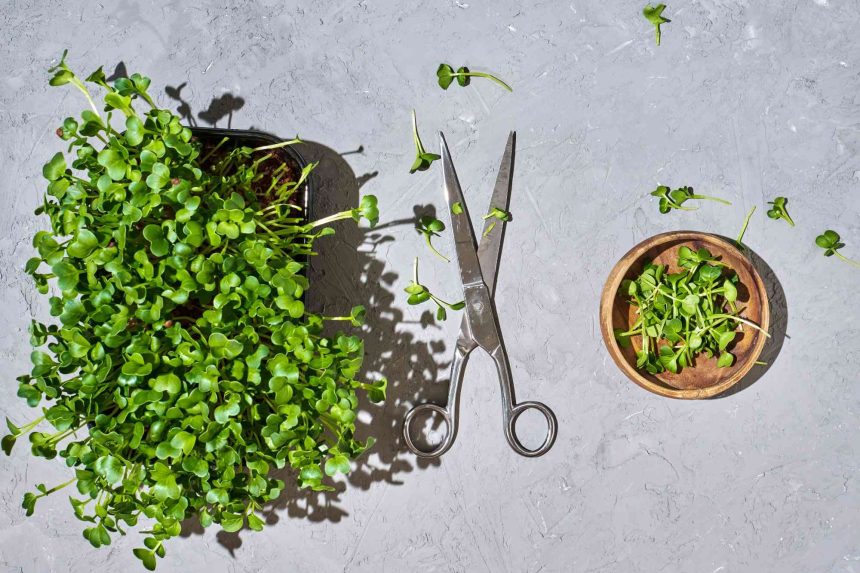They seem to be ubiquitous in trendy restaurants these days—and that’s not all. Microgreens are everywhere, from the farmers market to the grocery store. These mini vegetables are packed with flavor and even more; they’re nutritional powerhouses. Ahead, we chatted with chef Francois Payard about how to use these tiny but mighty greens.
François Payard, a third-generation chef who has worked at some of the world’s finest restaurants, including Le Bernardin and Daniel in New York City.
What Are Microgreens?
Microgreen is a marketing term that describes a growing category of young, tender, edible varieties of vegetables and herbs. Think of them like the shoots of salad vegetables picked after the first few leaves have developed, says chef François Payard.
Micro broccoli, micro wasabi mustard, micro kale, and micro watercress are all common varieties of microgreens. They’re larger than sprouts and smaller than baby vegetables. Microgreens can be grown indoors in very shallow soil. In fact, many home chefs and professionals may take to tending and harvesting a windowsill microgreen garden themselves for peak freshness.
What Do Microgreens Taste Like?
Microgreens vary, but as their name suggests, they taste like tiny, leafy greens. They have bursts of flavor reminiscent of the vegetables they could grow up to be. Typically, they are consumed raw and are relatively mild yet also earthy and fresh, and they can bring out flavor notes in a dish that may otherwise taste rather flat. Do not consider them a substitute if a recipe calls for a certain amount of kale or watercress. Rather, think of them as an accent, like a sprinkle of cinnamon on a hot cocoa or a dash of bitters in a cocktail.
Nutritional Benefits
In addition to their aesthetic and flavor qualities, microgreens are super healthy. A University of Maryland and USDA study in 2010 found that the tiny vegetables contain up to 40 times more nutrients than their fully mature counterparts. Further studies have echoed those findings, indicating a lot of vitamins and minerals in such a small package. Microgreens are so easy to consume (a handful is an acceptable snack) that there’s almost no excuse not to add an extra dose of nutrition atop your next meal.
How to Use Microgreens
“I use microgreens to add color and a burst of flavor to a dish,” Payard says. “You can use them as garnish for any dish and even for drinks, as well as to add seasoning to soups, layer them on any sandwich, add them to stews, and mix them into any salad.” At his restaurant, Southhold Social, on the North Fork of Long Island, N.Y., you’ll see microgreens atop dishes as a garnish—including in unexpected places, such as micro basil on a dessert. Wherever you want to add a hint of beauty and a small pop of fresh flavor, microgreens are an asset, whether you’re making a microgreen omelet in the morning or have a more complex recipe that can just use some extra oomph.
Microgreens are so versatile that no meal planning is required; they can be used on top of reheated pizza, takeout Thai, or your signature weeknight casserole. In fact, there’s really no place microgreens don’t belong.
Chefs will often use tweezers to set microgreens just so, but you can use clean fingers to (gently) place them as a garnish on an individual plate or shared dish. Using microgreens will make your contribution to any potluck look a lot more gourmet. And if you’re planning to snap an Instagram photo to show off your cooking, a sprinkle of microgreens truly takes that dish to the next level.
Where to Buy Microgreens
Many grocery stores, farmers markets, and CSAs all sell microgreens. They’re quick to grow, and supplies can easily be replenished (typically, no supply chain issues here!). They’re also small enough that they don’t take up much truck or shelf space.
While microgreens may cost more than boxes of salad greens, a package weighing a few ounces typically costs just a few bucks, and those microgreens can go far.
Storage Tips
“The best way to store microgreens is in a covered container in the bottom of the fridge,” says Payard. They’ll typically last three to five days, and you’ll want to check on them during that time to make sure they don’t get too moist and wilt. Microgreens are too delicate to freeze, but if you have some that need using up, consider making a pesto or soup with them that you can freeze. Of course, once defrosted, garnishing that dish with fresh microgreens will spruce it up.







